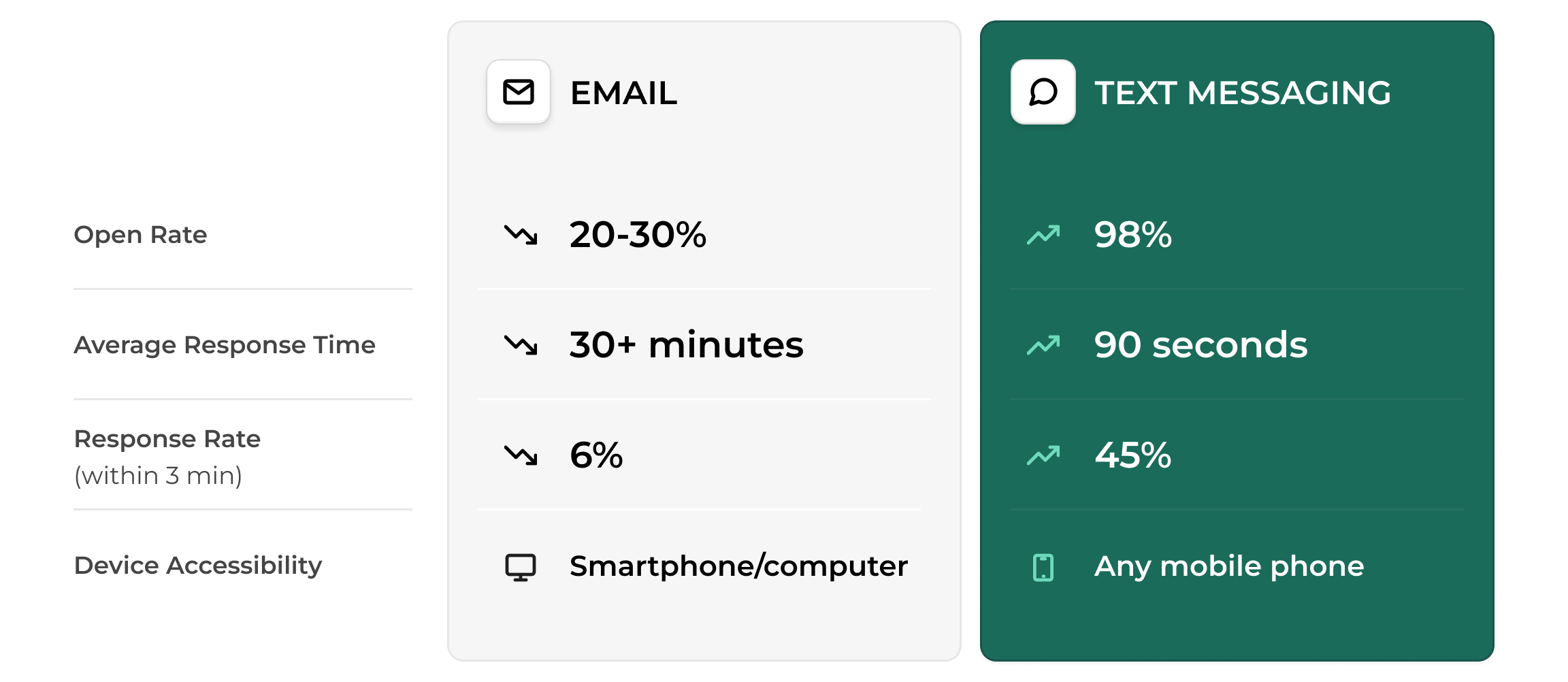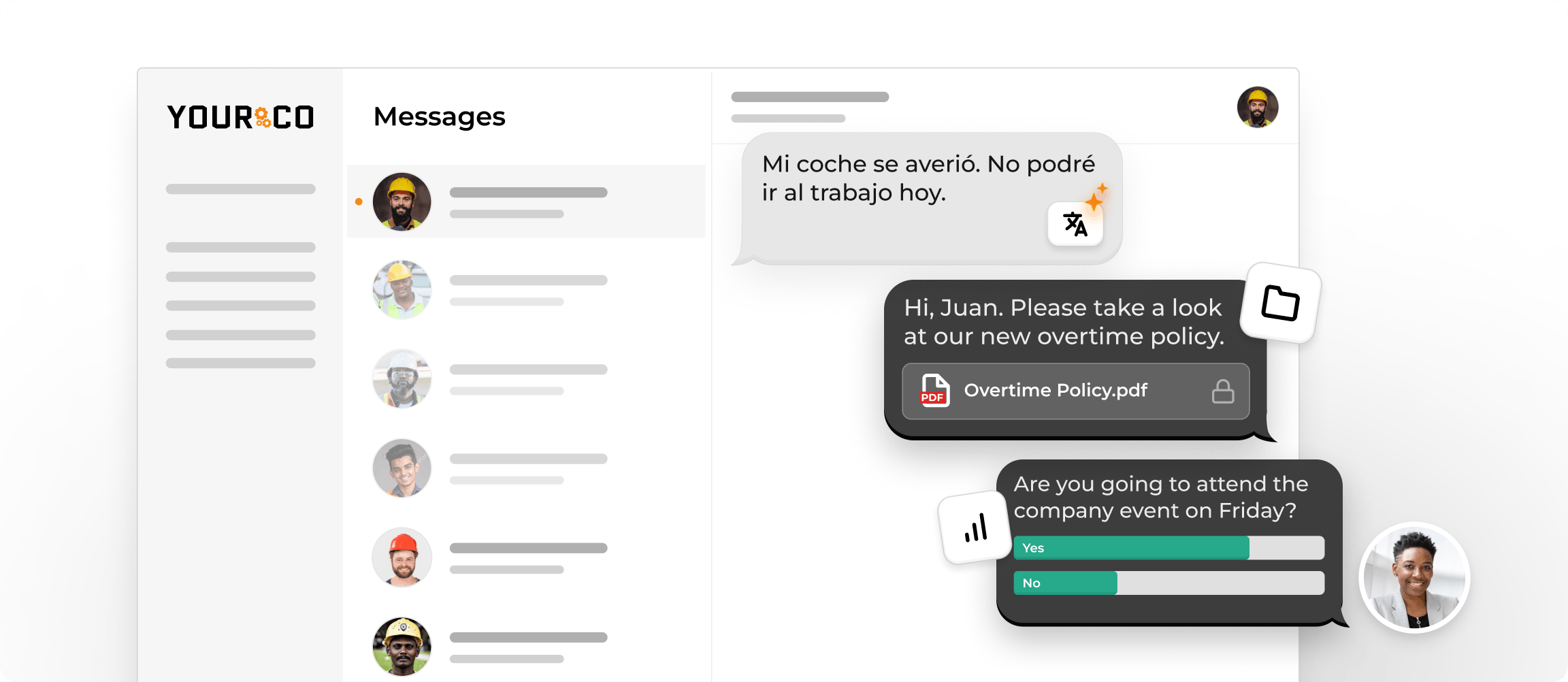4 Effective Communication Structures to Enhance Employee Engagement


Ever notice how some companies just seem to click while others constantly trip over their own feet? The secret often lies in their communication structure and how information moves through the organization. When messages flow smoothly from leadership to frontline workers and back again, everyone wins.
Think of your company's communication structure as its nervous system. It's not just about who talks to whom; it's about building pathways where important information reaches the right people at the right time, and everyone feels part of something bigger, no matter where they work.
Why is a Communication Structure Important?
A communication structure is the framework that determines how information travels throughout your company. It includes the formal and informal channels that connect people, departments, and hierarchical levels.
It encompasses all of your internal communication strategies: official channels, such as company announcements and scheduled daily communications, and unofficial ones, often called the "grapevine."
When done right, this structure ensures messages reach their intended audience clearly and efficiently. It shapes who gets what information, how feedback cycles back, and how ideas spread. This framework directly impacts your team's ability to make decisions, coordinate efforts, and achieve goals.
1. Direction-Based Communication Structures
Communication structures work in multiple directions:
- Vertically (up and down the hierarchy)
- Horizontally (between peers or departments)
- Diagonally (across different levels and departments)
Digital tools have expanded these structures beyond traditional boundaries. Email, messaging platforms, collaborative tools, and company intranets have transformed information sharing, especially for organizations with teams spread across different locations.
Downward Communication
In this communication structure, information flows from upper management to lower levels, including instructions, policies, and feedback. This is the most common organizational communication form, though it can create one-way information highways if not balanced with other types.
Upward Communication
This structure allows employees at lower levels to share information, feedback, or suggestions with higher management. Companies with strong upward communication make more informed decisions and maintain higher employee satisfaction because workers feel heard.
Horizontal Communication
Communication happens between peers or departments at the same level. This communication structure breaks down silos and encourages collaboration, letting teams coordinate without always going through management. Horizontal communication shines in projects requiring expertise from multiple departments.
Diagonal Communication
This involves communication between people at different levels and departments, cutting across traditional hierarchical lines. Diagonal communication boosts efficiency by connecting employees who need to work together but don't share reporting lines. It works particularly well in matrix organizations where employees answer to multiple managers.
2. Mode-Based Communication Structures
A mode-based communication structure categorizes communication methods by how messages are conveyed—whether spoken, written, or non-verbal. It helps organizations select the right medium to ensure clarity, efficiency, and impact for different situations and audiences.
Verbal Communication
Verbal communication refers to the exchange of messages through spoken words, either face-to-face or through media like phone calls and video conferences. It allows for immediate feedback and clarification.
In considering communication methods, it's important to weigh texting vs email in terms of effectiveness and convenience, especially for non-desk employees.

Oral Communication
Face-to-face talks, meetings, and phone calls allow for immediate feedback and clarification. You can read reactions in real-time and adjust your message accordingly.
Written Communication
Emails, reports, and memos create permanent records that people can refer back to. Written communication works best for complex details that recipients might need to review multiple times.
Non-Verbal Communication
Body language, facial expressions, gestures, and tone can either strengthen or contradict verbal messages. Studies suggest non-verbal cues make up over 50% of communication impact, making awareness of these signals important.
3. Network-Based Communication Structures
A network-based communication structure describes how information moves within a group or organization based on predefined patterns of interaction, such as chains, wheels, circles, or open networks. It determines the efficiency, clarity, and flow of organizational communication.
Chain Structure
In this communication structure, information moves vertically through the hierarchy, with each person communicating only with their immediate superior or subordinate. This creates clear accountability but can slow down information transfer and decision-making.
Wheel Structure
This structure centralizes communication through one individual who acts as the hub for all information. The wheel enables quick decisions but creates bottlenecks and limits collaboration.
Y-Structure
Combining features of both chain and wheel structures, the Y-structure allows information to flow from a central authority to multiple subordinates. This hybrid communication structure balances centralized control with some horizontal interaction.
Circle Structure
Communication flows in a circle, with each member connecting to two others. This structure promotes equal participation and encourages feedback, making it ideal for collaborative team projects.
All-Channel Structure
An open system where communication flows freely among all members. This approach sparks collaboration and innovation, but can become chaotic in larger organizations without proper guidance.
4. Formality-Based Communication Structures
A formality-based communication structure categorizes communication based on the level of formality, distinguishing between officially sanctioned channels and informal interactions. It guides how messages are conveyed within an organization, influencing clarity, speed, and workplace relationships.
Formal Communication
Structured communication follows official channels, roles, and responsibilities. It ensures consistency and documentation but often moves more slowly than informal channels.
Informal Communication
Unstructured, spontaneous interactions—often called the "grapevine"—significantly shape workplace culture and morale. Though unofficial, informal communication typically spreads information faster than formal channels and builds relationships among team members.
Barriers to Effective Communication Structures
Overcoming these barriers is crucial because effective communication directly impacts employee engagement, productivity, and organizational success. Failure to address them can lead to misunderstandings, decreased morale, increased errors, and ultimately, hindered organizational performance.
Linguistic Barriers
When employees don't share the same vocabulary or language background, misunderstandings multiply. Technical jargon that makes perfect sense to engineers might completely baffle the sales team.
For non-desk workers, corporate terminology can feel like a foreign language because it's often abstract, overly formal, and disconnected from their daily tasks and environment. This specialized language creates barriers by causing confusion, reducing employees' confidence in their understanding, and limiting their ability to engage meaningfully with company communications. Clear, plain-language messaging, combined with translation or simplified explanations, ensures everyone understands crucial information regardless of their role or language background.
Psychological Barriers
Our personal biases, emotions, and mental states color how we send and receive messages. We might dismiss perfectly valid feedback from a department we've had conflicts with before. These filters operate below our conscious awareness, making them particularly tricky to address.
For example, an overwhelmed employee might scan an important email without catching details. Someone feeling undervalued might hear neutral feedback as criticism. These psychological filters act like invisible walls between what's said and what's understood.
To overcome these challenges, consider exploring solutions for team communication.
Physical Barriers
Real-world obstacles often block effective communication structures. Factory floors with loud machinery make conversation nearly impossible. Teams spread across time zones struggle to find meeting times that work for everyone. Poor internet connections prevent field workers from accessing updates.
The physical separation between office and frontline staff creates particular challenges in reaching non-desk employees. When corporate teams rarely interact face-to-face with field employees, both sides miss the nonverbal cues and casual exchanges that build understanding and rapport.
Organizational Barriers
Rigid hierarchies and protocols can choke information flow. When messages must follow strict chains of command, bottlenecks form and information gets delayed or distorted. Middle managers might filter communications going up or down the chain, sometimes unintentionally changing the original message.
6 Strategies to Enhance Communication Structures
Implementing effective strategies can dramatically enhance your communication structures, helping your team navigate and overcome common barriers such as linguistic differences, physical obstacles, and organizational silos. Here are six practical steps to strengthen communication across your organization:
Implement Clear Communication Policies
Create straightforward guidelines defining which channels to use for different types of messages. Emergency alerts, policy updates, team collaboration, and social communication each need their own appropriate channels. Implementing effective workplace communication is essential in this process.
Make these policies accessible in multiple formats to help everyone understand, regardless of their learning style or work environment, following internal communications best practices.
Encourage Open Feedback
Create an atmosphere where people feel safe sharing ideas and concerns without fear of backlash. Organizations that prioritize two-way communication report much higher engagement among non-desk workers who otherwise feel disconnected from decision-making.
Set up both anonymous and named feedback channels to capture different types of input. Show that feedback matters by acknowledging input and taking visible action on suggestions when feasible.
Use Technology to Improve Communication Flow
Choose tools that fit your specific workforce rather than forcing employees to adapt to ill-suited platforms. For non-desk workers, simple SMS-based communication apps show much higher adoption rates than complex systems requiring extensive training. A text messaging service for business may help you to reach your workforce effectively.
ATS implemented digital signage to share real-time data with their distributed workforce, dramatically improving information flow to employees without regular computer access.
Offer Skills-Based Training for Better Communication
Provide communication skills training for everyone, focusing on both tech competence and people skills. Include practical workshops on listening, clear writing, presenting, and resolving conflicts.
Adapt training to different work schedules and locations. Make resources available for quick reference so people can refresh their skills when facing specific challenges.
Adopt a Multi-Channel Approach
Use diverse communication channels to reach employees in ways that work for them. Implementing non-desk employee communication strategies can help in adopting a multi-channel approach. Research confirms that important messages should travel through at least three different channels to ensure maximum reach and retention.
Personalize Communication for Better Understanding
Tailor messages to different employee groups based on their roles, information needs, and work environments. Segmentation ensures people receive relevant content without wading through information that doesn't apply to them.
Use analytics to improve timing and content. Let employees set preferences for non-critical communications, giving them some control over how they receive updates.
Measuring Success and Impact
To ensure you maintain a strong communication structure, you should measure its effectiveness. Start by tracking a few vital indicators of frontline engagement:
- Employee Sentiment: Track survey results on whether people feel informed and connected
- Operational Improvements: Monitor productivity, error rates, safety incidents, and customer satisfaction
- Tool Adoption: Measure voluntary usage of communication platforms
- Message Effectiveness: Track read rates, response times, and action completion
Qualitative Assessment
Conduct focus groups to understand the "why" behind communication patterns. Interview employees across departments for insights on barriers and improvements. Gather specific examples of when communication succeeded or failed.
Continuous Improvement
Communication structures require ongoing attention and adjustment. Regular audits help identify gaps between current practices and evolving needs. The best organizations view their communication structure as a living system that adapts alongside their workforce and business goals.
Connect Without Complication: The Yourco Advantage

Effective communication shouldn't require your frontline workers to download another app or learn complex technology. That's why Yourco offers a straightforward SMS-based solution that meets your non-desk employees exactly where they are—on their phones, using the texting functionality they already know and use every day.
Unlike email or complex software solutions, Yourco's SMS platform reaches your entire workforce instantly, with read rates exceeding 98%. This means your safety alerts, schedule changes, and company announcements actually reach your team members, whether they're in a warehouse, on a construction site, or serving customers on the retail floor.
Yourco also provides AI-powered translations, instantly communicating critical information in over 135 languages. This ensures every team member, regardless of language barriers, receives and fully understands vital updates. With built-in polls and surveys, you can quickly gather frontline feedback, gauge employee sentiment, and proactively address concerns, increasing overall engagement. Furthermore, Yourco’s frontline intelligence features offer detailed analytics such as attendance patterns and absenteeism trends, enabling you to identify issues early and optimize operational efficiency.
For more communication tips for deskless workers, Yourco provides solutions that reach your entire workforce. You can segment messages by department, location, or role to ensure everyone receives only relevant information, and your team can provide instant feedback without jumping through technological hoops.
As the #1 SMS-based employee app in the market, built specifically for the non-desk workforce, Yourco transforms how your organization's communication structure connects everyone, creating a more informed, engaged, and productive team.
Try Yourco for free today or schedule a demo and see the difference the right workplace communication solution can make in your company.



